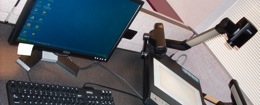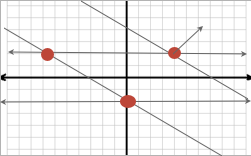What
is a tangent? Instructors often hate for students to "go off on
tangents," but they forget these student-tangents could be teachable
moments. They forget the mathematic idea of the tangent line as a line
that meets another element (curve, straight line, plane) at one
particular point along that element's surface.
There is immediate contact and a sense of connection. These tangent
lines sometimes start at one point in an element before branching off
into infinity; they branch off into new directions and leave
mathematicians to wonder about this new direction. The tangent can be
beneficial to expanding our notions of what it means to use portfolios
and multimodality in college composition classrooms.
Sometimes, the perpendicular and parallel lines drawn between
portfolios and
multimodal composition lead teachers and students to tangent lines
branching off of particular intersections. My tangent pages are meant
to mirror these tangential (though directly relevant) issues and ideas.
These tangent lines are not tangential in terms
of being side-notes; instead, these tangent lines act as new directions
to propel portfolios and multimodality forward in today's ever-changing
classrooms.
| Bringing multimodality into the composition classroom
Teachers’ initial exposure to different types of technology and the
possibilities of utilizing that technology in the composition classroom
often preclude a critical vision of how to incorporate those
technologies. As excitement builds and teachers attempt to include
multimodal writing assignments or uses of new and different programs
and hardware into the course, classroom goals and objectives may flounder and
deteriorate. Lenard (2007), for example, cautions that high
expectations for new assignments may ultimately occlude the
technological difficulties students face in using the new technology.
Additionally, high expectations of the technology may enable some
students’ hegemonic views to be foisted on other students during the
class’s acclimation to the new technology and assignments (Lenard, p.
78). Lenard mentions students who might use multimodal
assignments like blogging and commenting to attack openly gay or other
minority students in the classroom.
As Lundin (2008) suggests, even when technology does not silence
minority voices, incorporating contemporary technologies into the
classroom
with
little carry over to course objectives may be a waste of time for many instructors. In these instances, technology
has not been properly incorporated into the classroom. The instructor
is not aware of the tools’ potential or problems, and does not properly
introduce them or their possible uses to the class (Rice, 2008).
Implementing technology in this way is detrimental because it
doesn't add to the work students are doing. Students can tell when
the work does not correspond to the course objectives. Instructors
cannot forget: students have objectives and goals for courses that
sometimes align with, sometimes fall short of, and sometimes surpass
instructors' goals and objectives. Students know when they are being
lied to, and they know when something doesn't quite fit.
Because
the composition classes have so frequently been literature classes, and
because they often come out of the English department, students expect
a certain degree of literature and traditional essay writing. They do
not expect to be working with movie-making programs or designing
websites.
By carefully choosing which types of technology to use, and which
types of portfolios to build, instructors can help students see the
writing that exists beyond the traditional essay. Using portfolios and
multimodality together in a composition classroom can be effective, but
we need to spend time planning on how these things can be built into
the course, how they can enhance the course, and what type of new
intellectual work they push our students towards.
|


